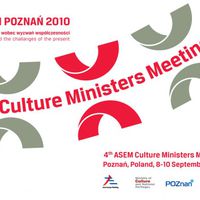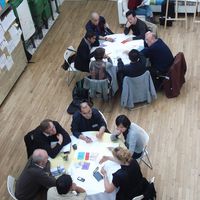Vietnam:ASEM Workshop on enhancing visibility through cultural activities
ASEM is an informal dialogue process between 27 EU Member States, the European Commission, 16 Asian countries, and the ASEAN Secretariat. It has three main pillars: political, economic and cultural cooperation. Despite the trans-regional partnerships, broad range of activities, and 14 years of existence, ASEM’s visibility remains relatively low.
The idea of an integrated strategy for promoting ASEM’s image came to light in the 6th ASEM Summit Helsinki in 2006. Vietnam has been eager to follow-up on the idea and took a proactive role in the following 7th ASEM Summit in Beijing in 2008, when it raised the proposal for organizing a workshop dedicated to enhancing ASEM’s visibility. The workshop came to realization in April, 28-29 2010, at one of Vietnam’s most famous attractions and a recognized world heritage – Ha Long Bay in Quang Ninh Province. With the partnership of the Hungarian government and the Asia Europe Foundation (ASEF), the Vietnamese Ministry of Foreign Affairs and Ministry of Culture and Sport hosted this workshop. Over 100 participants from ASEM governments including senior officials, UNESCO and ASEF representatives, experts on culture, artists, journalists, academics, and observers from candidate countries of Russia and Australia, joined in the three-day intensive dialogue.
The workshop is aimed at designing a proposal for the upcoming 4th ASEM Culture Ministers’ Meeting in Poznan in September 2010 and the 8th ASEM Summit to be held in Belgium in October this year. The topics of the debates concentrated on the following:
(i) the modality of cultural diplomacy in ASEM framework
(ii) the role of civil societies and NGOs in the ASEM cultural cooperation
(iii) ASEF’s cultural activities as a contribution in increasing ASEM’s visibility.
General consensus was reached upon the need for increased cultural exchange and artistic connectivity between Asia and Europe in order to erase prejudices, enhance mutual understanding and foster synergy between the two regions. The theme of the event itself proved the growing importance of culture in multilateral relations, and the very fact that culture has been incorporated into the political dialogue. Moreover, the fact that the activity engaged civil societies, NGOs, media, practitioners, artists and individuals next to government officials showed recognition that cultural diplomacy is no longer a domain for states to practice, but that other actors now play an increasingly active role.
Culture diplomacy, being considered a strategy for enhancing the visibility of ASEM dialogue, was discussed in the first session. Among the major findings of the workshop was the paradigm shift from one-way cultural diplomacy. In other words, promoting “own culture” and practised by governments towards cultural cooperation which engages multilaterally. Ambassador Helena Drnovsek Zorko stressed that ASEM should pay more attention to the civil societies’ input and invite them in the process of cultural policy-making and decision-making to wider community of cultural practitioners rather than keep it in the high level of ministerial debates. The changing understanding of cultural diplomacy and visibility brings to the forefront the role of non state agencies.
Consequently, civil society and NGOs became the topic of the following panel, where representatives from relevant organizations from ASEM member states, as well as individual practitioners were heard. A wide scope of concerns were discussed, ranging from the best practices from several international platforms for cultural cooperation, suggestions for strategy for intensified exchange, to defining the very meaning of visibility and awareness of the dialogue within the ASEM process. “The notion of visibility equals being relevant in target audiences and being legitimate among the key stakeholders,” recognized Mr. Anmol Vellani, Director of India Foundation for the Arts, India. To enhance visibility, the participation of the target audiences should be increased as well. That could be reached by higher mobility of artist and the creation of sustainable networks, particularly strengthening intra-Asian networks to avoid imbalances.
On the second day of the workshop the debate continued engaging participants to share their experiences and ideas for the recommendation. The representatives from Asia-Europe Foundation, Ms. Sabina Santarossa, the Director of Culture Exchange Department and Ms. Valentina Riccardi presented on ASEF initiatives to bridge peoples of Asia and Europe through cultural, intellectual and people-to-people exchanges. Among ASEF’s important contribution was initiating the culture360.org website, which is a unique and first-ever online platform providing cultural information and connecting artists, cultural practitioners and policy makers from Europe and Asia. The dynamic online portal is an excellent way of increasing ASEM’s visibility. Participants acknowledged the contribution of ASEF in raising awareness about the ASEM process, and the relevance of its sustainability. It was recommended that financial support is required for the continuity of ASEF’s activities and digital platforms like culture360.org.
The scope of issues tackled during the two-day meeting was wide; hence distraction from the main track was inevitable at some moments. The very distinction between intention of promoting national culture and contributing to the visibility strategy got blurred away in few presentations. Perhaps it would have been more efficient if there was more specific focus on whether a unilateral, bilateral or multilateral approach in understanding and practising cultural diplomacy should be taken. And although there was a common agreement among the participants in acknowledging the need to enhance awareness about ASEM, the characterization of the visibility itself varied from different perspectives. Throughout the workshop the tools for increasing visibility were very clearly expressed. The Vietnamese government came up with succinct examples of its successful cultural diplomacy and the accomplishment of the Year 2009 of Cultural Diplomacy. However, some questions were raised but were left largely unanswered. How should visibility be understood? Who are the actors and target audience of the visibility process? How would the ASEM process be affected when its visibility is enhanced?
What the speakers agreed on was the complexity of the issue. Strategies targeting different levels of audience would vary. Thus, to effectively enhance visibility, the adopted strategy would need to be flexible and comprehensive enough to encompass a full spectrum of, not only in the very diverse Asian and European realities, but also to be accurate enough for various groups in each society.
The strongest message from the workshop was the affirmation of the importance of cultural interaction, which contributes to the development of common values among the Asian and the European peoples and should not remain solely in the politicized sphere. Whether or not it is defined as cultural diplomacy or cultural cooperation, the relevance of the process is now recognized across the regions, despite the existing differences. And the relevance itself is the key to sustainability, as well as to the visibility of the process. After all, as Ambassador Dominique Girard, the Executive Director of ASEF said, “It’s not about ASEM promoting itself, but promoting values it represents”.
Overall, the workshop was considered a success. The main objectives were reached, which given the richness of the issues and limited time scope, was extremely fruitful. The Ha Long meeting was an exercise in fine dialogue, bringing voices from many Asian and European member states, as well as the representatives from different professional groups in a constructive atmosphere, resulting in some practical recommendations, good practices to learn from, and new ideas for further exchange.
Le Thu Huong is a PhD candidate in inter-disciplinary Asia-Pacific Studies at National Chengchi University, Taipei, Taiwan. She was born in Hanoi, Vietnam but has lived many years in Cracow, Poland, where she obtained her BA and MA from Jagiellonian University in International and Cultural Studies. Huong has conducted research in Southeast Asian regionalism and the identity formation, Asia-Europe cultural inter-regionalism and the cultural development in Vietnam. Huong is also a fellow of UNESCO U40 World Forum “Cultural Diversity 2030” and serves as informal ambassador to the region to promote the UNESCO Convention on the Protection and Promotion of Diversity of Cultural Expressions. She speaks fluently in 5 languages and has working experience as interpreter to diplomatic delegations, including Presidential visits.
For more related articles on www.culture360.org please refer to: Recommendations, Vietnam Workshop: Enhancing ASEM visibility
For more related articles in the China Daily, please refer to: Hard-sell of 'soft power'
Similar content
posted on
12 May 2010
posted on
18 May 2010
posted on
07 Sep 2010
posted on
20 Apr 2010
posted on
12 Jul 2010
posted on
11 Aug 2010





